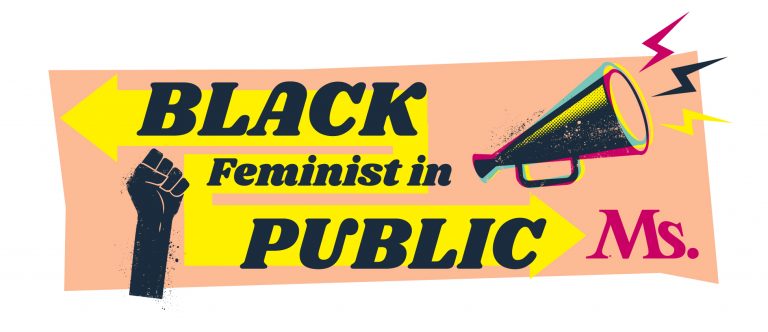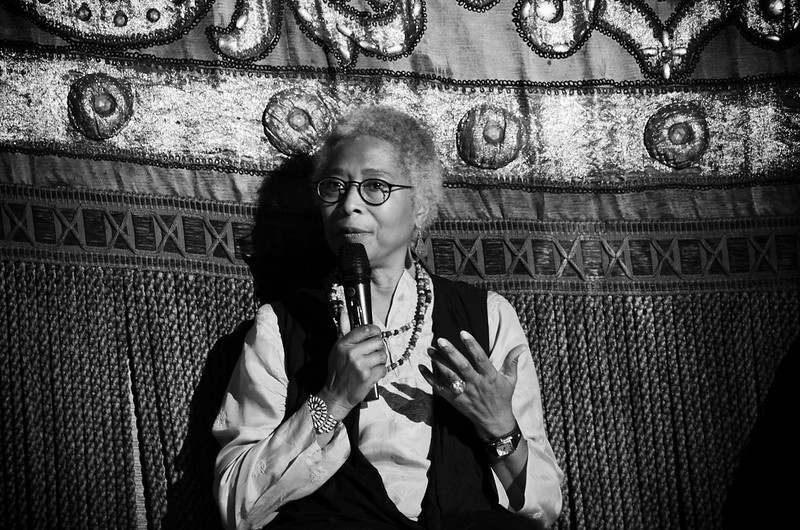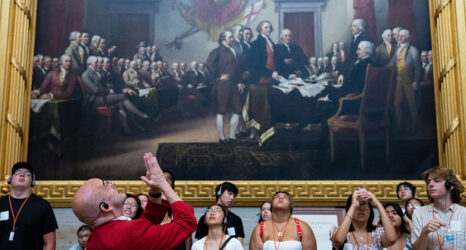
Black Feminist in Public is a series of conversations between creative Black women and Janell Hobson, a Ms. scholar whose work focuses on the intersections of history, popular culture and representations of women of African descent.
It was nearly 40 years ago when writer Alice Walker became the first Black woman to win the Pulitzer Prize for fiction for her widely praised novel The Color Purple (1982). The novel was later adapted into a critically acclaimed film (1985) directed by Steven Spielberg that was as equally controversial as the novel and further launched the careers of women like Whoopi Goldberg and Oprah Winfrey. Winfrey eventually adapted the novel into a hit Broadway musical.
As we celebrate the latest Pulitzer Prize-winning works of literature and journalism, Janell Hobson had an opportunity to chat with Black feminist scholar and New York Times contributing writer Salamishah Tillet. Tillet recently penned In Search of the Color Purple: the Story of an American Masterpiece, which revisits Walker’s groundbreaking novel and its cultural impact.

Janell Hobson: I’m always amazed when I teach and find out that students don’t know the novel The Color Purple. They might know of the Broadway show and the movie, but they’re forgetting the novel.
Salamishah Tillet: Yes, but they may know the memes from the movie, which I find most people are familiar with right now.
Hobson: What does it mean for you to go back and reclaim this book?
Tillet: I think of two things.
One, Alice Walker famously reclaimed Zora Neale Hurston in her essay “Looking For Zora.” That process of reclamation and rediscovery is so central to how Black women artists, activists and intellectuals have had to make way for themselves in the world. We often go back in time and find someone who somehow—despite all of the restrictions imposed on her—was able to find her way in the world. And as we’re trying to understand who we are and make space for ourselves, we reclaim them. It was important for me to recognize Alice’s own journey to Zora as part of my own journey to Alice. That’s one thing.
The other part is that you have a generation of Black writers and scholars who self-identify as Black feminists who remember the moment or the time or the text that helped them find the language of Black feminism.
Hobson: So, your book is really focused on a genealogy of Black feminism.
Tillet: Yes. This is an origin story of myself. When did I become a Black feminist? Who made it possible for me to think about these forms of oppression, these multiple forms of oppression at once? Who gave me permission to cut against the grain and articulate my own trauma, not as a detraction from that project but in service of racial liberation? This is both a recovery and an origin story.

Hobson: What is your own specific relationship to Walker’s The Color Purple?
Tillet: I read The Color Purple in the summer of 1991, and there were two other books that I read alongside it. One was Toni Morrison’s The Bluest Eye and the other one was Malcolm X’s autobiography as told to Alex Haley. That trio, that trinity of texts, for me, really made me understand the experiences I was having as a Black girl who was living in the United States. With The Bluest Eye, Morrison was foregrounding Black girls coming of age, of trauma, of community, of holding people accountable or not holding people accountable enough, and also internalized racism. Malcolm X diagnoses white supremacy in stark terms. But it was The Color Purple that I think I lost myself the most in, that I was able to see Celie and the community that she built and the community that she helped heal as part of her own journey to self. It was such a rich and vivid and loving space, a world that is so oppressive originally but by the end, she’s redefined the terms of how she’s going to exist in that world. That’s pretty stunning. It’s a story of feminism really, and it’s a story of Black people resisting segregation. It’s a story of love and intimacy and creating a beloved community through blended family.
Hobson: Absolutely! The novel addressed so many different ideas about religion, spirituality, family, sexuality, everything. I was young when the book came out, but I do remember the controversies around it, especially when the movie came out.
You think about the kind of furor that was created out of the book, and even now I’m thinking of the way that through social media, Black audiences get caught up in what’s an acceptable way of talking about our pain and our stories. What would the reception have been like if The Color Purple were published for the first time in our own era?
Tillet: I’ve never thought about that. In some ways, The Color Purple—and this is one of the arguments I make in my book—made so much possible. A Black girl who is a sexual assault survivor and the central character of a novel, that idea was so new, but we’ve now seen that in other stories since then, whether it’s Sapphire’s Push, for example, or other artists who have taken up that theme and run with it. The Color Purple was the first book that so unapologetically centered the voice of a Black girl, a survivor of sexual violence.
Then there’s the relationship between Shug and Celie, which was the other controversy. It showed Black men as violent figures, first with her Pa and then in the home with Albert after marriage, but then it also shows Celie finding love in the arms of Shug, another Black woman. So, you have African American men as the perpetrators of violence but then, you have Celie rejecting that violence and finding solace in a relationship with Shug, both of which were seen as demonizing Black men.
I think now we have much more sophisticated understandings of Black queer families, Black queer couples, Black women’s sexualities. It’s still contentious, but I think we’ve made progress compared to the 1980s in terms of how we can understand the fluidity of Black women’s sexualities. But we still have unresolved issues in our moment around Me Too and marriage equality. We’re still not able to have full accountability, nor do we have figures who seek redemption and atonement for their bad behavior and their violence, the way we see in the character of Albert in the novel.
“The Color Purple … made so much possible. A Black girl who is a sexual assault survivor and the central character of a novel—that idea was so new.”
Hobson: You’re reminding me just how much Alice Walker has been influential with regards to our conversations about Black women’s experiences, sexual assault survivors, about various fluid sexualities. I think we are able to even have these conversations now because of the precedent that her novel established.
Tillet: Yes. Also, it’s the content of the story and the way she told the story. I think that’s also one of the contentions against the book in that she foregrounded it in the Black southern vernacular English that Celie spoke. I think we would now understand that kind of writing as highly experimental, a bit avant-garde. But back then she was rejected by Essence magazine. They didn’t want to run an excerpt of The Color Purple, which seems absurd now, but at that time, I guess the politics of respectability shaped these ideas that this kind of language would be a caricature of Black people. There are so many ways that the novel not only anticipated where we are now but helped to create where we are now.

Hobson: What I find very powerful about what Alice Walker did with The Color Purple in writing through the vernacular is to invent language for a character’s silence. Celie didn’t have the language for what happened to her in terms of her sexual assault, so she wrote these intimate letters to God, which the author then makes us privy to. It is mitigating a kind of silence but also asks us to think of how we give voice to the silence.
I think that’s something that now we’ve been vocalizing with the Me Too movement, but that is also what makes the novel so revolutionary and why I think it’s amazing that you’ve explored this book’s place in our culture and not just within Black feminist scholarship but just in literature in general.
Tillet: The Color Purple is without a doubt one of the most accomplished American novels written. Whether we look at Walker winning the Pulitzer and the National Book Award, or the 11 Oscar nominations for the film adaptation, or the Tony Award-winning musical. There is no other book that’s had such a celebrated existence.
At the same time, it has produced so much controversy, to the point of boycotts and bans and censorship and real in-fighting. I guess that’s why I wanted to make the case for Walker’s genius. Our culture still celebrates many of the white male authors, like the recent Hemingway documentary or the Salinger films that keep on coming out despite his own problematic past. Even when Black women defy all the odds of whatever industries have set up as their own standard of excellence, we still have to go recover them. It’s not the same as Zora Neale Hurston dying in obscurity and Alice having to pay for her tombstone. But we still have to guard against Black women’s genius going unrecognized.
Hobson: I understand you had an opportunity to meet with Alice Walker. Can you say more about that?
Tillet: That conversation changed the entire sense of the book’s direction. I had the opportunity to talk about the inspiration for Celie, her grandmother Rachel Little, and Alice has talked about this book ad nauseam and at infinitum, but she still teared up when she was thinking about the life that her grandmother had and the violence that she experienced. Alice wanted to give her a different ending in The Color Purple through the character of Celie. That was pretty remarkable to talk to the person and try to understand what they were thinking as they imagined this world and made it possible for us to see. It was daunting as a reader to meet the person whose book has meant so much to me as I found my own voice as a scholar, as a survivor, and as an activist.
“It was daunting as a reader to meet the person whose book has meant so much to me as I found my own voice as a scholar, as a survivor, and as an activist.“
Hobson: I can see that. I’m thinking of your own role as a Black feminist in public, both as a public scholar as well as the work you’ve done with your sister with the organization, A Long Walk Home. Could you talk more about how you put those two things together?
Tillet: Well, The Color Purple and its various iterations resonate so strongly with me for most of my adulthood because I am a sexual assault survivor. The Color Purple has been so central to my own healing and then in my life, my sister and I created the organization A Long Walk Home that came out of her generous sisterly act of documenting my healing with her camera as a photographer.
We created an organization to center the lives of Black girls and young women who live at the intersections of gender-based violence and racial violence, which is meant to empower them to create art and campaigns that address their vulnerability and advocate for other girls. The Color Purple is the book that I return to, but also it is a template for our belief in A Long Walk Home in the power of art to help heal and also to create worlds in which violence does not exist. I dedicate the book to my sister, as you know, and then to A Long Walk Home.
Hobson: What connects your work and Alice Walker’s The Color Purple is the goal of healing. It’s not retributive justice. After all, Albert does get a redemptive end and is not banished (the way he is in Spielberg’s film).
Tillet: That’s the biggest misreading of the book. I think the film doesn’t give us that in its fullness, but the Broadway musical really is in response to the film and tries to return to the image Alice gives us of Albert’s arc. That’s why it’s fascinating to watch a book have so many lives. Every decade has its own The Color Purple.
Up next:





